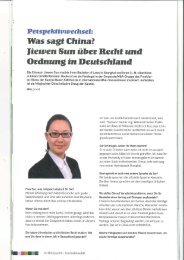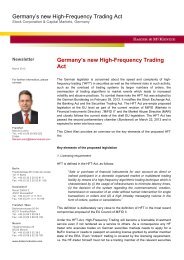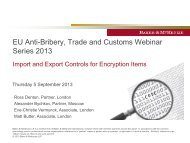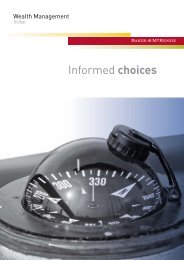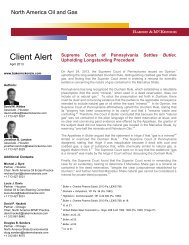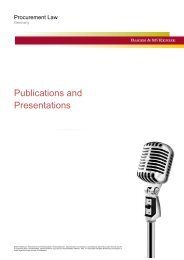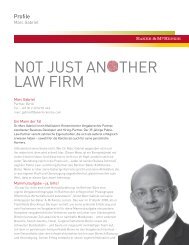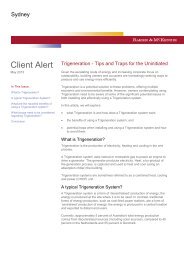Read publication - Baker & McKenzie
Read publication - Baker & McKenzie
Read publication - Baker & McKenzie
You also want an ePaper? Increase the reach of your titles
YUMPU automatically turns print PDFs into web optimized ePapers that Google loves.
The Tax Disputes<br />
and Litigation<br />
Review<br />
Editor<br />
Simon Whitehead<br />
Law Business Research
The Tax Disputes and<br />
Litigation Review<br />
Reproduced with permission from Law Business Research Ltd.<br />
This article was first published in The Tax Disputes and Litigation Review, 1st edition<br />
(published in March 2013 – editor Simon Whitehead).<br />
For further information please email<br />
Adam.Sargent@lbresearch.com
The Tax Disputes<br />
and Litigation<br />
Review<br />
Editor<br />
Simon Whitehead<br />
Law Business Research Ltd
The Law Reviews<br />
The Mergers and Acquisitions Review<br />
The Restructuring Review<br />
The Private Competition Enforcement Review<br />
The Dispute Resolution Review<br />
The Employment Law Review<br />
The Public Competition Enforcement Review<br />
The Banking Regulation Review<br />
The International Arbitration Review<br />
The Merger Control Review<br />
The Technology, Media and<br />
Telecommunications Review<br />
The Inward Investment and<br />
International Taxation Review<br />
The Corporate Governance Review<br />
The Corporate Immigration Review<br />
The International Investigations Review<br />
The Projects and Construction Review<br />
The International Capital Markets Review<br />
The Real Estate Law Review<br />
The Private Equity Review<br />
The Energy Regulation and Markets Review<br />
The intellectual property Review<br />
The asset management review<br />
THE PRIVATE WEALTH AND PRIVATE CLIENT REVIEW<br />
The mining law review<br />
The Anti-Bribery and<br />
Anti-Corruption Review<br />
THE Executive Remuneration Review<br />
The Cartels And Leniency Review<br />
The Tax Disputes AND Litigation Review<br />
www.TheLawReviews.co.uk
Publisher<br />
Gideon Roberton<br />
business development managerS<br />
Adam Sargent, Nick Barette<br />
marketing managerS<br />
Katherine Jablonowska, Thomas Lee and James Spearing<br />
PuBLishing assisTanT<br />
Lucy Brewer<br />
Production Co-ordinator<br />
Lydia Gerges<br />
Head of Editorial Production<br />
Adam Myers<br />
production editor<br />
Anne Borthwick<br />
subeditor<br />
Joanne Morley<br />
editor-in-chief<br />
Callum Campbell<br />
managing director<br />
Richard Davey<br />
Published in the United Kingdom<br />
by Law Business Research Ltd, London<br />
87 Lancaster Road, London, W11 1QQ, UK<br />
© 2013 Law Business Research Ltd<br />
No photocopying: copyright licences do not apply.<br />
The information provided in this <strong>publication</strong> is general and may not apply in a specific<br />
situation. Legal advice should always be sought before taking any legal action based<br />
on the information provided. The publishers accept no responsibility for any acts or<br />
omissions contained herein. Although the information provided is accurate as of<br />
February 2013, be advised that this is a developing area.<br />
Enquiries concerning reproduction should be sent to Law Business Research, at the<br />
address above. Enquiries concerning editorial content should be directed<br />
to the publisher – gideon.roberton@lbresearch.com<br />
ISBN 978-1-907606-57-1<br />
Printed in Great Britain by<br />
Encompass Print Solutions, Derbyshire<br />
Tel: 0844 2480 112
acknowledgements<br />
The publisher acknowledges and thanks the following law firms for their learned<br />
assistance throughout the preparation of this book:<br />
AMIT, POLLAK, MATALON & CO ADVOCATES<br />
AND NOTARY<br />
BAKER & MCKENZIE LLP<br />
ECONOMIC LAWS PRACTICE<br />
FLICK GOCKE SCHAUMBURG<br />
GIDE LOYRETTE NOUEL<br />
Hage Aaronson<br />
HANNES SNELLMAN ATTORNEYS LTD<br />
HERGÜNER BILGEN ÖZEKE ATTORNEY PARTNERSHIP<br />
KROMANN REUMERT<br />
LOYENS & LOEFF<br />
MAISTO E ASSOCIATI<br />
MASON HAYES & CURRAN<br />
i
Acknowledgements<br />
MORAIS LEITÃO, GALVÃO TELES, SOARES DA SILVA<br />
& ASSOCIADOS, RL<br />
MORRISON & FOERSTER LLP<br />
NISHIMURA & ASAHI<br />
OPF PARTNERS<br />
PWC LEGAL CIS BV<br />
SCHELLENBERG WITTMER<br />
SKEPPSBRON SKATT<br />
STC PARTNERS<br />
URÍA MENÉNDEZ<br />
ii
contents<br />
Editor’s Preface<br />
...............................................................................................vii<br />
Simon Whitehead<br />
Chapter 1<br />
Tax Appeals to the<br />
European Court of Justice ................................... 1<br />
Paul Farmer<br />
Chapter 2 BELGIUM ............................................................................ 9<br />
Caroline P Docclo<br />
Chapter 3 CANADA ........................................................................... 22<br />
Jacques Bernier and Mark Tonkovich<br />
Chapter 4 DENMARK ........................................................................ 40<br />
Arne Møllin Ottosen and Kristine Laursen<br />
Chapter 5 FINLAND .......................................................................... 51<br />
Ossi Haapaniemi, Lauri Lehmusoja and Meeri Tauriainen<br />
Chapter 6 FRANCE ............................................................................ 62<br />
Eric Ginter and Julien Bellet<br />
Chapter 7 GERMANY ......................................................................... 77<br />
Michael Hendricks<br />
Chapter 8 HUNGARY ......................................................................... 89<br />
Eszter Kamocsay-Berta, Dániel Gera and Márton Hajnal<br />
iii
Contents<br />
Chapter 9 INDIA .............................................................................. 101<br />
Naresh Thacker and Prabhjyot Chhabra<br />
Chapter 10 IRELAND ......................................................................... 111<br />
John Gulliver and Robert Henson<br />
Chapter 11 ISRAEL ............................................................................. 122<br />
Doron Levy<br />
Chapter 12 ITALY ............................................................................... 141<br />
Guglielmo Maisto<br />
Chapter 13 JAPAN .............................................................................. 154<br />
Akihiro Hironaka, Michito Kitamura and Masaki Noda<br />
Chapter 14 LUXEMBOURG ............................................................... 165<br />
Frédéric Feyten and Guy Perrot<br />
Chapter 15 NETHERLANDS ............................................................. 176<br />
Thies Sanders and Almut Breuer<br />
Chapter 16 PORTUGAL ..................................................................... 188<br />
Francisco de Sousa da Câmara and António Lobo Xavier<br />
Chapter 17 RUSSIA ............................................................................. 201<br />
Yana Proskurina<br />
Chapter 18 SPAIN ............................................................................... 219<br />
Jesús López Tello<br />
Chapter 19 SWEDEN ......................................................................... 234<br />
Ulrika Grip and Fredrik Mattsson<br />
iv
Contents<br />
Chapter 20 SWITZERLAND .............................................................. 244<br />
Harun Can and Pietro Sansonetti<br />
Chapter 21 TURKEY .......................................................................... 254<br />
Ayşe Hergüner Bilgen and Ayşegül Akbal<br />
Chapter 22 UNITED KINGDOM ...................................................... 269<br />
Simon Whitehead<br />
Chapter 23 UNITED STATES ............................................................ 291<br />
Edward L Froelich<br />
Appendix 1 ABOUT THE AUTHORS ................................................ 321<br />
Appendix 2 CONTRIBUTING LAW FIRMS’ CONTACT DETAILS .. 335<br />
v
Editor’s Preface<br />
The objective of this book is to provide tax professionals involved in disputes with<br />
revenue authorities in multiple jurisdictions with an outline of the principal issues<br />
arising in those jurisdictions. In this, the first edition, we have concentrated on the key<br />
jurisdictions where disputes are likely to occur for multinational businesses.<br />
Each chapter provides an overview of the procedural rules that govern tax appeals<br />
and highlights the pitfalls of which taxpayers need to be most aware. Aspects that are<br />
particularly relevant to multinationals, such as transfer pricing, are also considered. In<br />
particular, we have asked the authors to address an area where we have always found<br />
worrying and subtle variations in approach between courts in different jurisdictions,<br />
namely the differing ways in which double tax conventions can be interpreted and applied.<br />
Perhaps it is merely a perception from a jurisdiction whose Prime Minister<br />
has publicly vilified a multinational for complying with the national tax laws, but tax<br />
avoidance seems to have become the new international evil. As such, this book provides<br />
an overview of each jurisdiction’s anti-avoidance rules and any alternative mechanisms<br />
for resolving tax disputes, such as mediation, arbitration or restitution claims.<br />
We have attempted to give readers a flavour of the tax litigation landscape in each<br />
jurisdiction. The authors have looked to the future, and have summarised the policies<br />
and approaches of the revenue authorities regarding contentious matters, addressing<br />
important questions such as how long cases take and situations in which some form of<br />
settlement might be available.<br />
We have been lucky to obtain contributions from the leading tax litigation<br />
practitioners in their jurisdictions. Many of the authors are members of the EU Tax<br />
Group, a collection of independent law firms, of which we are members, involved<br />
particularly in challenges to the compatibility of national tax laws with EU and EEA<br />
rights. We hope that you will find this book informative and useful.<br />
Finally, I would like to acknowledge the hard work of my colleague Federico<br />
Cincotta in the editing and compilation of this book.<br />
Simon Whitehead<br />
Hage Aaronson<br />
London<br />
February 2013<br />
vii
Chapter 3<br />
CANADA<br />
Jacques Bernier and Mark Tonkovich 1<br />
I<br />
INTRODUCTION<br />
Taxation in Canada falls within both federal and provincial jurisdiction. While each<br />
province enjoys the exclusive power to impose direct taxes within its borders in order to<br />
raise revenues for provincial purposes, Canada’s Constitution enshrines the Canadian<br />
Parliament’s broad authority to impose any system of taxation. 2 This structure gives rise<br />
to a complex web of laws, including multiple regimes for personal and corporate income<br />
taxes, sales and commodity taxes, excise taxes, and property and estate taxes. The federal<br />
Income Tax Act (‘the Act’) 3 stands against this background both as the leading paradigm<br />
for the resolution of civil tax disputes and as the primary source of tax jurisprudence. 4<br />
Federally, the Minister of National Revenue is responsible for administering and<br />
enforcing the Act. The Minister’s powers are normally exercised through officials of the<br />
Canada Revenue Agency (‘the CRA’). The CRA also administers and collects almost all<br />
provincial personal and corporate income taxes under federal-provincial tax collection<br />
1 Jacques Bernier is a partner and Mark Tonkovich is an associate at <strong>Baker</strong> & <strong>McKenzie</strong> LLP.<br />
2 Apart from one coming within a province’s exclusive jurisdiction over direct taxes in the<br />
province (see Constitution Act, 1982, being Schedule B to the Canada Act 1982 (UK), 1982,<br />
c. 11, ss. 91(3), 92(2)).<br />
3 R.S.C. 1985 (5th Supp.), c. 1. Unless otherwise specified, all references to statutory provisions<br />
in this chapter, including references to particular sections (‘s.’ or ‘ss.’) or parts thereof, are to the<br />
Act.<br />
4 Among other things, the Act contains federal tax rules relating to the income of individuals,<br />
corporations, trusts, partnerships, and other entities and organisations, both those resident<br />
in Canada (in which case income tax is generally imposed on worldwide income) and nonresident<br />
(in which case income tax is generally imposed on income that is considered sufficiently<br />
connected to Canada).<br />
22
Canada<br />
agreements. 5 Most of the underlying provincial regimes parallel or expressly incorporate<br />
large portions of Canada’s federal tax laws, including the Act’s sophisticated system of<br />
administrative objections and judicial appeals. Despite this formal structure, taxpayers<br />
are often able to resolve disputes through less formal negotiations with the CRA in the<br />
course of tax audits or through pre-emptive measures taken before the commencement<br />
of any formal audit. Although the majority of tax disputes are resolved at these earlier<br />
stages, traditional tax litigation remains prevalent in Canada and large numbers of tax<br />
disputes are decided in court.<br />
When planning for potential litigation, taxpayers must weigh the benefits of the<br />
court process against its inherent uncertainties, and the investment of time and resources<br />
required to mount a proper judicial appeal. Current trends suggest that growth areas for<br />
civil tax litigation in Canada include anti-avoidance matters, transfer pricing issues, interjurisdictional<br />
tax planning, and the classification of novel types of receipts or deductions<br />
(such as the tax treatment of contractual break fees or hybrid financing arrangements).<br />
These areas tend to involve unsettled legal questions and fact-intensive scenarios with<br />
greater potential litigation gains than those with developed bodies of jurisprudence.<br />
Compared to civil tax disputes, criminal tax litigation in Canada is quite rare.<br />
Criminal tax prosecutions arise most often in relation to tax evasion, fraudulent benefit<br />
claims, deceitful misrepresentation, or the failure to provide information or returns to<br />
the CRA. Criminal tax offences incorporate concepts of intentional wrongdoing (i.e.,<br />
both an actus reus and a mens rea). They are punishable by significant penalties, including<br />
fines and potential imprisonment, designed to redress the wrongs done to society at large<br />
rather than to the raising of public revenues. Short of meeting the criminal threshold,<br />
Canadian tax authorities may also apply a wide assortment of regulatory or civil penalties<br />
for improper taxpayer conduct.<br />
II<br />
COMMENCING DISPUTES<br />
i Civil tax disputes<br />
The formal process for resolving civil tax disputes commences after the CRA or a<br />
provincial tax authority issues written notification that it has assessed a taxpayer<br />
– typically by way of a ‘notice of assessment’. That notice identifies the amount of a<br />
taxpayer’s liability under a particular tax statute or statutes. In the normal course of<br />
events, the underlying assessment is made following an examination of tax returns and<br />
5 The CRA currently administers all personal income taxes in each of Canada’s three territories and<br />
in nine of its 10 provinces – Quebec being the single exception. Similarly, the CRA administers<br />
both federal and provincial corporate income taxes in all provinces except Quebec and Alberta.<br />
Ontario, Canada’s most populous province, only joined the tax collection agreement scheme<br />
for corporate income taxes in 2009. Ontario corporate income taxes for taxation years ending<br />
before 1 January 2009 continue to be administered under the prior provincial tax system and<br />
dispute resolution structure.<br />
23
Canada<br />
the taxpayer’s activities relating to a particular period or transaction. 6 Depending on<br />
the nature of the examination, the taxpayer may have been subject to any number of<br />
information-gathering audit activities prior to the actual assessment of tax. The taxpayer<br />
will normally also have been advised in writing of the basis for the assessment and will<br />
have been given opportunities to make representations concerning any controversial<br />
factual or legal issues. The significance of these pre-assessment interactions cannot be<br />
overemphasised: most disputes will be resolved through communications with the tax<br />
authority well before the making of a formal assessment. Once made, however, a tax<br />
assessment is deemed to be valid and binding and can only be modified through the<br />
formal objection and judicial appeal process, or by virtue of a subsequent reassessment<br />
made under the same statute. 7<br />
The required first step in commencing the objection and appeal process is filing a<br />
written notice of objection that sets out the relevant facts and reasons for the objection. 8<br />
Under the Act, taxpayers must normally object within 90 days of the disputed assessment,<br />
irrespective of the length of the audit leading up to the assessment or the number of issues<br />
that the assessment covers. 9 Unlike other taxpayers, most corporations 10 are obligated to<br />
include extensive details in their written objections, and any subsequent litigation will<br />
be limited to the issues raised in those documents. 11 They are also obligated to pay 50 per<br />
cent of any disputed amount fixed by an assessment while waiting for the outcome of<br />
the objection and appeal process. 12 Although the same obligation does not apply to other<br />
taxpayers, many taxpayers will pay the disputed amount in full, since the interest on any<br />
unpaid portion is usually non-deductible and is calculated at a substantially higher rate<br />
than that which applies to tax refunds.<br />
6 Normally, Canadian tax authorities are only able to reassess taxpayers within a statutory<br />
‘normal reassessment period’. For most taxpayers, that period expires three years after the initial<br />
tax assessment for a particular taxation year, but it will be longer in a number of specified<br />
circumstances (where additional time might be required to reassess). For example, the normal<br />
reassessment period for private corporations that are not Canadian-controlled is four years<br />
rather than three, and any reassessment is permitted for an additional three years where it<br />
is made as a consequence of a transaction with a non-resident, non-arm’s-length person (ss.<br />
152(3.1)(a), (4)(b)(iii)). Similarly, the limitation period will not apply where the taxpayer has<br />
supplied fraudulent information under the Act or where the taxpayer has expressly waived its<br />
right to the statutory limitation period for the particular year (s. 152(4)(a)).<br />
7 See, e.g., s. 152(8).<br />
8 It is notable that an objection may be made against almost any tax assessment, even a ‘quick<br />
assessment’ that assesses the taxpayer in complete conformity with its earlier tax returns.<br />
9 See s. 165(1).<br />
10 This rule applies to ‘large corporations’. These are corporations employing more than C$10<br />
million of taxable capital in Canada, calculated along with the Canadian taxable capital of any<br />
related corporations (s. 225.1(8)).<br />
11 See ss. 165(1.11), 169(2.1).<br />
12 See note 10; see, e.g., s. 225.1(7).<br />
24
ii<br />
Criminal tax prosecutions<br />
Canada<br />
The distinction between criminal and civil tax matters is significant to the dispute<br />
resolution process because there are extensive constitutional and procedural protections<br />
that apply only in the criminal context. 13 Criminal tax prosecutions will arise only after<br />
the formal laying of charges under a federal statute 14 and normally proceed in provincial<br />
courts of general jurisdiction. Although charges relating to less serious ‘summary<br />
conviction’ offences must be laid within eight years of the purported offence, 15 there is<br />
no equivalent limitation period for the more serious ‘indictable’ class of offences.<br />
III<br />
THE COURTS AND TRIBUNALS<br />
i Objections to federal tax assessments<br />
A taxpayer’s objection will be considered ‘with all due dispatch’ 16 by the CRA’s Appeals<br />
Branch. This branch is an independent internal division of the CRA mandated to conduct<br />
an impartial and expeditious review of the objection and the underlying assessment. The<br />
taxpayer will have the opportunity to engage in significant negotiations with the Appeals<br />
Branch, during which time the taxpayer may decide to submit new information and<br />
documentation in support of its objection. 17 Once the Appeals Branch completes its<br />
review, it will confirm, vary or vacate the initial assessment, or will otherwise reassess the<br />
taxpayer. 18 If the taxpayer continues to dispute the assessment (or any reassessment issued<br />
in response to its objection), or if 90 days have passed from the date of the objection<br />
and the CRA has yet to complete its review, the taxpayer has the option of appealing the<br />
assessment directly to court without further negotiating with the CRA. 19<br />
13 See Guindon v. Canada for a recent discussion of the classification of tax penalties (2012 TCC<br />
287, appeal pending).<br />
14 Both Parliament and the provincial legislatures also have the authority to create ‘quasi-criminal’<br />
or regulatory offences. These assist in maintaining high standards of public health, safety and<br />
order in a limited sphere of activity, but do not relate to acts or omissions considered truly<br />
wrongful in a moral sense. In general terms, regulatory offences incorporate a lower threshold<br />
of wrongdoing and attract fewer procedural protections, less-significant penalties and less social<br />
stigma than federal criminal offences.<br />
15 See s. 244(4).<br />
16 There is no formal time period for processing an objection, but there exists a developing body of<br />
jurisprudence interpreting the CRA’s obligations to issue assessments and respond to objections<br />
in a timely manner.<br />
17 The taxpayer may also generally submit new information or documents at the Tax Court appeal<br />
stage, but a variety of potential negative consequences may flow from a taxpayer’s failure or<br />
refusal to provide information to the CRA at earlier stages.<br />
18 See s. 165(3). In practice, a reassessment to increase taxes payable will not be made in response<br />
to an objection as a matter of administrative practice or because reassessment is statute-barred.<br />
19 See s. 169(1). An appeal to the Tax Court must normally be initiated within 90 days from the<br />
day the CRA sends the taxpayer notice that it has confirmed the assessment or has reassessed in<br />
response to an objection.<br />
25
ii<br />
Canada<br />
Appeals to the Tax Court of Canada<br />
The Tax Court of Canada, a specialised court completely independent of the CRA, has<br />
exclusive original jurisdiction over appeals from tax assessments made under the Act.<br />
Only the correctness of the assessed amounts is in issue at this stage. In particular, the<br />
Tax Court cannot reduce an assessment in respect of how CRA officials have treated a<br />
taxpayer, how that treatment compares with that of other similarly-situated taxpayers,<br />
or any other sympathetic or mitigating circumstances. 20 The Court holds trials across<br />
Canada, and a single judge (and no jury) hears each appeal. Each judge was a practising<br />
lawyer prior to his or her appointment, and many of the Court’s judges have extensive<br />
tax practice experience. The taxpayer and the CRA are each represented by experienced<br />
tax litigators in any substantial appeal.<br />
Only taxpayers may appeal assessments to the Tax Court. This occurs in one<br />
of two ways: under the ‘informal procedure’ for appeals involving smaller monetary<br />
amounts, 21 and through the Court’s ‘general procedure’ in all other cases. 22 All tax<br />
appeals are effectively de novo proceedings and are not limited to the material before<br />
the CRA at the audit or objection stages. They are also adversarial in nature: taxpayers<br />
and the CRA each have an opportunity to make their case through direct oral testimony<br />
and documentary evidence, cross-examination and detailed legal argument. The CRA<br />
has the initial benefit of relying on any factual ‘assumptions’ it made in the course of<br />
issuing or confirming the disputed assessment. To the extent that the taxpayer disagrees<br />
with any significant assumption, the taxpayer has the burden of putting evidence before<br />
the Court to rebut that assumed fact. 23 The judge will then weigh the evidence and the<br />
parties’ factual assertions on the balance of probabilities and in accordance with the<br />
Court’s interpretation of the relevant law. Ultimately, the Court will dispose of the appeal<br />
20 See, e.g., Main Rehabilitation Co v. Canada, 2004 FCA 403, 2004 D.T.C. 6762. See also<br />
Section V.ii, infra, concerning challenges to the CRA’s administrative activities.<br />
21 The informal procedure appeal process effectively creates a ‘small claims court’ for federal tax<br />
disputes and removes the need for many of the litigation formalities that operate under the<br />
general procedure. For example, under the informal procedure, originating court documents<br />
may be prepared in summary fashion, the Court and the parties are not bound to follow any<br />
formal rules of evidence, and the parties may be represented by non-lawyers. Currently, the<br />
informal procedure may only be used to obtain a reduction of up to C$12,000 per taxation<br />
year in disputed federal taxes and penalties, or an increase of up to C$24,000 per taxation year<br />
in disputed tax losses (to be raised to C$25,000 and C$50,000, respectively, under proposed<br />
legislation).<br />
22 It is also possible to refer particular legal or factual questions to the Tax Court for a binding<br />
determination outside the traditional assessment appeal process (see, e.g., ss. 173, 174).<br />
23 This structure reflects the rule that the CRA’s assessment is deemed to be correct in law and that,<br />
in Canada’s self-reporting system, the taxpayer (and not the CRA) is in control of information<br />
relating to its affairs and so should bear the burden of ‘demolishing’ the assumptions on which<br />
the assessment is based. Although rare, the taxpayer may also argue that particular assumptions<br />
were not actually made and thus cannot be relied upon to justify the assessment.<br />
26
Canada<br />
by directly substituting its view of the correct assessment for the CRA’s assessment, 24<br />
referring the assessment back to the CRA for reassessment with particular instructions,<br />
or dismissing the appeal and leaving the assessment intact.<br />
iii Appeals from Tax Court decisions<br />
Both taxpayers and the CRA have a right to appeal judgments and orders of the Tax<br />
Court of Canada to the Federal Court of Appeal. 25 Appellate review proceeds on the basis<br />
of the record before the Tax Court, and parties are unlikely to have an opportunity to<br />
present new evidence on appeal. If either party is unsatisfied with the Court of Appeal’s<br />
disposition, it may seek permission to further appeal the matter to the Supreme Court<br />
of Canada. 26 The Supreme Court may agree to hear an appeal where it considers any<br />
underlying question to be of such public or national importance that it warrants the<br />
Court’s attention. Since the Supreme Court typically decides between two and four tax<br />
appeals per year, the Federal Court of Appeal is the final adjudicator in most federal tax<br />
matters.<br />
iv Objections and appeals to provincial tax assessments<br />
When a civil tax dispute concerns the same issues under parallel federal and provincial<br />
legislation, the federal objection and appeal process will normally proceed, and the related<br />
provincial tax matter will be determined based on the outcome of the federal process. 27<br />
In contrast, if a dispute concerns solely provincial tax issues, the taxpayer must follow<br />
the particulars of the applicable provincial objection scheme. It will then have a right<br />
to appeal the underlying assessment to a court of general jurisdiction in the assessing<br />
province (rather than to a specialised tax court), to that province’s court of appeal and,<br />
with leave, to the Supreme Court of Canada.<br />
24 The Court may only decrease the assessment or leave it intact; it may not increase the disputed<br />
amount.<br />
25 The Federal Court of Appeal is an intermediary appellate court that hears all appeals from orders<br />
of the Tax Court of Canada, the Federal Court and certain federal administrative tribunals. Its<br />
judges come from a wide range of practice backgrounds (not limited to tax), and frequently<br />
have experience as judges of first instance in lower federal or provincial courts. Historically,<br />
approximately 25 to 30 per cent of proceedings in the Federal Court of Appeal are appeals from<br />
the Tax Court.<br />
26 The Supreme Court of Canada is Canada’s highest appellate court and is the final level of<br />
judicial review for all litigation in Canada. The Court hears appeals on all subject matters from<br />
every Canadian jurisdiction, in both official languages and arising under either the common or<br />
civil law tradition.<br />
27 Although such inter-jurisdictional matters raise a variety of issues, coordination is often achieved<br />
through provincial legislation that designates federal assessments or Tax Court dispositions as<br />
binding in respect of provincial tax issues, or which mandates that provincial tax authorities<br />
reassess taxpayers to achieve consistent treatment across federal and provincial regimes.<br />
27
v<br />
Criminal tax prosecutions<br />
Canada<br />
Like civil appeals of provincial tax assessments, criminal tax prosecutions normally<br />
proceed in provincial courts of general jurisdiction. Judges come from a wide variety of<br />
legal practice backgrounds and may have little or no experience in tax matters. Criminal<br />
tax litigation follows the same format as the prosecution of non-tax offences. This may<br />
involve various constitutional, procedural and jurisprudential particularities that have no<br />
application to civil tax appeals. The office of the federal or provincial Attorney General,<br />
which represents the public interest, has the burden of leading evidence to prove the<br />
taxpayer’s guilt beyond a reasonable doubt.<br />
vi Tax disputes broken down by numbers 28<br />
Annual activities (civil tax disputes)<br />
Objections resolved by CRA Appeals Branch 55,000–<br />
60,000<br />
Appeals to Tax Court of Canada 4,250–4,750<br />
Appeals to Federal Court of Appeal 100–150<br />
Appeals to Supreme Court of Canada
Canada<br />
whether such an infraction actually occurred, taxpayers may successfully defend<br />
against a variety of civil penalties by showing that they exercised due diligence in the<br />
circumstances (despite committing the infraction). 31 Objections or judicial appeals from<br />
an assessment will determine the correct taxes payable along with the correct quantum (if<br />
any) of applicable civil penalties. Notably, however, the CRA cannot increase the amount<br />
payable in response to an objection or appeal once the statutory reassessment period has<br />
ended. 32 A taxpayer may be liable for both civil and criminal penalties in respect of the same<br />
activities. On the criminal side, penalties generally range from relatively minor fines 33 to<br />
fines equalling a specified multiple of the tax sought to be evaded and imprisonment for<br />
a term not exceeding five years. 34 The minimum or maximum penalty depends largely on<br />
whether the prosecution is in respect of a ‘summary conviction’ offence or an ‘indictable’<br />
offence (the latter being the more serious). 35<br />
V<br />
TAX CLAIMS<br />
i Recovering overpaid tax<br />
The Act provides for the return of monies paid in respect of taxes where a taxpayer does<br />
not actually owe the amounts paid. For example, a taxpayer may have made payments<br />
on account of tax or may have been subject to withholding on the receipt of income<br />
from other parties during a particular taxation year. In the normal course of events, the<br />
taxpayer’s initial assessment for that year will reveal the overpayment and the resulting<br />
refund will issue automatically.<br />
Beyond this, the general statutory rule obligates the CRA to refund any overpaid<br />
amount without delay if the taxpayer filed its tax return within three years of the end<br />
of the taxation year in issue, and the taxpayer requests its refund during the period<br />
within which the CRA can reassess the taxpayer. 36 If the taxpayer is an individual<br />
or testamentary trust, the CRA has discretion to issue a refund at any time, as long<br />
as the taxpayer filed its tax return within 10 years of the end of the taxation year in<br />
question. 37 However, no refund will issue unless the taxpayer has also filed all tax<br />
31 See, e.g., Canada v. Consolidated Canadian Contractors Inc (1998), [1999] 1 F.C. 209, 98<br />
G.T.C. 6303 (C.A.).<br />
32 See notes 6 and 18.<br />
33 For example, a bond or debenture issuer who fails to record a prescribed code on any coupon<br />
evidencing a right to interest on the bond or debenture is liable on summary conviction to a<br />
fine not exceeding C$500 (s. 240(2)).<br />
34 See s. 239(2)(b), which applies to convictions for indictable offences relating to tax evasion, the<br />
making of false or deceptive statements or omissions, destruction or alteration of tax records, or<br />
conspiracy to commit any of these offences.<br />
35 Many tax offences are ‘hybrid’ in that the Attorney General may elect to proceed in either<br />
manner.<br />
36 See s. 164(1).<br />
37 See s. 164(1.5)(a).<br />
29
Canada<br />
returns that it is obligated to file under a host of federal tax statutes. 38 Where a taxpayer<br />
falls outside both the general rule and the few available discretionary exceptions, 39<br />
its only remedy will be bringing a lawsuit for unjust enrichment against the taxing<br />
jurisdiction or seeking a tax remission order from the government (as discussed in<br />
Section VII.vi, infra).<br />
ii Challenging administrative decisions<br />
In addition to filing an internal service complaint with a particular tax authority, taxpayers<br />
enjoy a general right to seek judicial review of any Canadian tax authority’s administrative<br />
decisions, practices or failures to act. Challenges to the CRA’s administrative activities 40<br />
are brought in Federal Court. 41 In contrast to the Tax Court’s limited jurisdiction<br />
in an appeal from an assessment, the breadth of issues that may be raised in Federal<br />
Court is quite broad. These include constitutional or jurisdictional questions about<br />
the CRA’s authority to act, the propriety of legal or factual interpretations that led to<br />
an administrative decision, and the fairness of the procedures followed by the CRA.<br />
However, this judicial review process cannot be used to launch an indirect attack against<br />
any issued assessment, since the Federal Court lacks jurisdiction to modify assessed taxes,<br />
interest or penalties.<br />
Depending on the nature of the questions in issue, a court sitting in review of<br />
impugned administrative activity will review the matter on the standard of ‘correctness’<br />
or the deferential standard of ‘reasonableness’. Whereas a correctness review shows no<br />
deference to the tax authority’s conduct or decision-making, a reasonableness review<br />
is concerned with whether there exists sufficient justification, transparency and<br />
intelligibility in the decision-making process. 42 If the taxpayer succeeds in its judicial<br />
review application, the court will usually return the underlying matter to the tax authority<br />
for reconsideration in accordance with specific directions.<br />
38 See s. 164(2.01).<br />
39 For example, the CRA may also refund an overpaid amount at any time where the overpayment<br />
is the result of a reassessment that waives interest or penalties, is made further to an accepted<br />
late-filed tax election or relates to amounts withheld by another person on account of certain<br />
tax liabilities of non-residents (see generally ss. 164(1.5)(b), (c)). In addition, a taxpayer may<br />
request that a statute-barred overpayment be ‘re-appropriated’ to pay a subsequent liability<br />
under the Act or a host of other tax statutes (see s. 221.2).<br />
40 Corresponding provincial court procedures exist in respect of provincial tax authorities’<br />
administrative activities.<br />
41 The Federal Court is Canada’s national trial court. It hears legal disputes arising in a wide variety<br />
of fields and in both common and civil law jurisdictions. In contrast to the Tax Court, the<br />
Federal Court is a court of both common law and equity. This allows it the discretion to fashion<br />
a variety of remedies appropriate to any particular dispute, as opposed to ‘merely’ interpreting<br />
and applying taxing provisions. The Federal Court has exclusive original jurisdiction to<br />
hear applications for judicial review from the decisions or activities of most federal boards,<br />
commissions and tribunals, including the CRA.<br />
42 See generally Dunsmuir v. New Brunswick, 2008 SCC 9, [2008] 1 S.C.R. 190.<br />
30
Canada<br />
iii Claimants<br />
The general rule is that only the taxpayer who is the subject of an assessment will object<br />
or appeal the assessment. 43 This coincides with the fact that most Canadian tax disputes<br />
concern direct taxes imposed on the assessed taxpayer. In contrast, in the case of indirect<br />
taxes such as the goods and services tax and the harmonised sales tax, the subject of<br />
the assessment is typically the supplier responsible for collecting the tax payable by the<br />
recipient of a taxable supply. 44 However, the law allows the CRA to assess either the<br />
supplier or the recipient where the supplier fails to collect tax on a particular supply. 45<br />
Where the supplier collects the tax but fails to remit it to the CRA, the recipient is<br />
relieved of any further obligation and cannot be assessed. 46 Where the supplier collects<br />
and remits an amount on account of tax that was not actually payable, the recipient (or<br />
the supplier, in limited circumstances) may seek a rebate from the CRA for the amount<br />
paid. 47 Any person who has been assessed may object and appeal from the assessment. 48<br />
Similarly, a resident making certain payments to a non-resident is responsible for<br />
withholding and remitting income tax to the CRA on the non-resident’s account, despite<br />
the fact that the non-resident is itself liable for the tax. 49 Where the resident payer fails<br />
to withhold and remit an amount on the non-resident’s behalf, the resident also becomes<br />
liable and will typically be assessed in respect of that same tax. 50 The assessed resident or<br />
non-resident may then follow the usual objection and appeal procedure under the Act.<br />
VI<br />
COSTS<br />
Canadian courts normally order an unsuccessful litigant to pay an amount to the<br />
successful party in respect of costs associated with bringing or responding to civil tax<br />
claims. 51 These discretionary awards provide only partial compensation to the successful<br />
party and often fall far short of the actual expenses incurred. However, an increased<br />
costs award may be made against a party that has acted in a reprehensible manner or<br />
43 Tax liability is normally considered to be a private matter between the taxpayer and the state.<br />
Nevertheless, it is possible for other interested parties to take part in the Canadian tax dispute<br />
resolution process in various ways, including as formal interveners in the course of judicial<br />
appeals.<br />
44 See, e.g., Excise Tax Act, R.S.C. 1985, c. E-15, s. 165(1) (‘ETA’).<br />
45 ETA, ibid., ss. 296(1)(a) (i.e., allows for the assessment of the supplier in respect of its ‘net tax’),<br />
296(1)(b) (i.e., allows for the assessment of the tax payable by the purchaser).<br />
46 See, e.g., Airport Auto Ltd v. Canada, 2003 TCC 683, 2003 G.T.C. 899-105.<br />
47 ETA, see note 44, s. 261.<br />
48 ETA, ibid., ss. 301(1.1), 302.<br />
49 See, e.g., Part XIII of the Act; especially ss. 212(1), 215(1).<br />
50 See ss. 215(6), 227(10).<br />
51 The Act also contains a rarely-used mechanism that permits the Tax Court to order a taxpayer<br />
to pay an additional 10 per cent of any amount disputed in an appeal where there were no<br />
reasonable grounds for the appeal, or where one of the main purposes for the appeal was to<br />
defer the payment of an amount payable (s. 179.1).<br />
31
Canada<br />
has unnecessarily delayed the litigation process. Outside of civil litigation, the taxpayer<br />
can only be required to pay for the CRA’s administrative costs in limited (voluntary)<br />
circumstances. 52 Similarly, the tax authorities will not be responsible for costs incurred<br />
by taxpayers in the course of preparing their tax filings or resolving disputes out of<br />
court. However, taxpayers will normally be able to deduct such expenses for income tax<br />
purposes. 53<br />
Costs awards in the criminal context are very rare. Criminal courts tend to use<br />
costs awards in only two circumstances: to control abuses of court process or in response<br />
to the infringement or denial of an accused taxpayer’s fundamental rights.<br />
VII<br />
ALTERNATIVE DISPUTE RESOLUTION<br />
i General principles and settlement<br />
The CRA has a statutory obligation to assess taxes based solely on its appreciation of<br />
the facts and in accordance with what it considers to be the correct interpretation of the<br />
law. 54 As a result, the CRA has no authority to enter into compromise settlements with<br />
taxpayers based on external considerations such as the costs involved or the risks inherent<br />
in litigating a tax dispute in court. For the same reasons, it is not possible for taxpayers<br />
and Canadian tax authorities to subscribe to private arbitration for the resolution of tax<br />
disputes. Although private non-binding mediation is available, it is very rarely used in<br />
practice. Nevertheless, taxpayers can take advantage of a number of additional avenues<br />
for seeking relief, whether prior to undertaking a particular transaction, following the<br />
completion of that transaction, or in response to unreasonable or abusive conduct at the<br />
hands of a Canadian tax authority. 55<br />
ii Before the transaction<br />
Prior to entering into a proposed transaction, taxpayers may request an advance ruling<br />
as to how the CRA will interpret particular tax provisions in respect of the transaction.<br />
Similarly, they may request a technical interpretation of tax provisions, which is not tied<br />
to a proposed transaction. Both the rulings and the technical interpretation procedures<br />
are creatures of administrative practice and discretion. 56 Although the CRA will normally<br />
consider itself bound by advance rulings, this is not so with technical interpretations, and<br />
the CRA may refuse to provide either a ruling or a technical interpretation in various<br />
52 For example, with respect to taxpayers’ requests for advance tax rulings from the CRA, or the<br />
assembly and disclosure of information under statutory access to information regimes.<br />
53 See, e.g., s. 60(o).<br />
54 See, e.g., Galway v. Minister of National Revenue, [1974] 1 F.C. 600, 74 D.T.C. 6355 (C.A.);<br />
CIBC World Markets Inc v. Canada, 2012 FCA 3, 2012 G.T.C. 1011.<br />
55 In addition to the alternative dispute resolution avenues identified above, taxpayers may also<br />
consider active lobbying aimed at achieving a change in the law that gives rise to their tax<br />
dispute.<br />
56 See CRA, Information Circular IC70-6R5, ‘Advance Income Tax Rulings’ (17 May 2002).<br />
32
Canada<br />
circumstances. 57 Taxpayers are also required to pay for the comfort provided by an<br />
advance ruling: hourly fees apply to compensate the CRA for the work conducted on a<br />
taxpayer’s behalf. 58<br />
iii After the transaction<br />
Following the close of a transaction or the end of a taxation period, but before the<br />
initiation of any related audit or enforcement action, taxpayers may make a ‘voluntary<br />
disclosure’ to correct inaccurate or incomplete information previously provided to the<br />
CRA. 59 The benefit of such disclosures is that the taxpayer will be liable for the taxes and<br />
certain interest amounts relating to the prior inaccuracies, but will be saved from civil or<br />
criminal penalties that may otherwise apply. Taxpayers may also seek to file amended tax<br />
returns to correct prior inaccuracies or to take advantage of elective measures that they<br />
did not claim in their original returns. Although the CRA will be obligated to process an<br />
amended tax return in limited circumstances, 60 doing so often depends on the exercise<br />
of administrative discretion which can only be employed within the applicable statutory<br />
reassessment period. 61 It is also possible for taxpayers to obtain a discretionary waiver or<br />
cancellation of interest or penalties in sympathetic circumstances by requesting ‘taxpayer<br />
relief’. 62 Similarly, taxpayers may undertake a transaction only to later realise that<br />
they were mistaken in doing so and that the transaction that was carried out (or the<br />
legal effect of that transaction) differs from what the parties had intended. In such<br />
circumstances, taxpayers may be able to obtain a court order rescinding the transaction<br />
or rectifying the relevant transaction documents so as to carry out their true intentions.<br />
The benefit of such an order is that Canadian tax authorities will be bound to follow<br />
the court’s retroactive ruling as to the nature and legal characteristics of the transaction<br />
in question. 63<br />
57 For example, where an issue is before the courts, where it concerns proposed rather than enacted<br />
legislation or where doing so would require the CRA to opine on foreign law.<br />
58 The fee payable for an advance ruling is currently C$100 for each of the first 10 hours spent in<br />
preparing the ruling and C$155 for each subsequent hour (Canada, S.O.R./2000-322, s. 2).<br />
59 See CRA, Information Circular IC00-1R2, ‘Voluntary Disclosures Program’ (22 October<br />
2007). The voluntary disclosure programme has roots both in statutory provisions and in<br />
administrative practices. Canadian courts are yet to fully define the scope of the CRA’s powers<br />
and obligations in this context.<br />
60 For example, where the taxpayer seeks to carry deductions arising in a subsequent taxation year<br />
back to a prior year (s. 152(6)).<br />
61 CRA, Information Circular IC75-7R3, ‘Reassessment of a Return of Income’ (9 July 1984); see<br />
also note 6.<br />
62 CRA, Information Circular IC07-1, ‘Taxpayer Relief Provisions’ (31 May 2007).<br />
63 Where a particular transaction has multijurisdictional consequences, foreign tax authorities<br />
may also recognise a Canadian court order in certain circumstances.<br />
33
iv<br />
International tax disputes<br />
Canada<br />
Where a dispute involves issues covered by one of Canada’s international tax conventions,<br />
taxpayers may also have the option of seeking relief through dispute resolution procedures<br />
provided under a tax treaty. These may include seeking relief through the contracting<br />
states’ mutual agreement procedures or entering into an advance pricing arrangement<br />
on transfer pricing matters. Furthermore, certain of Canada’s bilateral treaties also allow<br />
(or require) contracting states to refer unresolved disagreements to binding arbitration.<br />
For example, Canada’s treaties with the United States and Switzerland 64 provide for<br />
mandatory arbitration where the countries’ competent authorities are unable to resolve<br />
a dispute covered by the treaties. Taxpayers often stand to benefit from pursuing these<br />
international dispute resolution avenues in parallel with domestic dispute resolution<br />
strategies, but it may be necessary to hold one proceeding in abeyance pending the<br />
completion of the other.<br />
v Alternative forms of litigation<br />
As discussed in Section V.ii, supra, taxpayers also enjoy a general right to bring judicial<br />
proceedings to challenge administrative decisions, practices or failures to act. In a similar<br />
vein, where a taxpayer has been subjected to particularly egregious conduct, the taxpayer<br />
has the option of initiating a civil lawsuit against the relevant tax authority or against<br />
particular tax officials. Although taxpayers regularly succeed in judicial review proceedings<br />
in respect of administrative activities in the tax sphere, successful civil actions against<br />
Canadian tax authorities or officials are exceedingly rare.<br />
vi Remission orders<br />
Finally, where they have been unable to obtain relief against civil tax assessments through<br />
any of the traditional or alternative dispute resolution procedures, taxpayers may seek a<br />
tax remission order from the particular taxing jurisdiction. Remission orders are formal,<br />
discretionary decisions made by the executive branch of government that excuse taxpayers<br />
from debts considered to be unreasonable, unjust or where forgiveness is otherwise in<br />
the public interest. To illustrate, the CRA tends to recommend remission in only four<br />
situations:<br />
a in cases of extreme hardship;<br />
b where CRA officials have acted incorrectly or given incorrect advice;<br />
c where financial setback is coupled with extenuating factors beyond the taxpayer’s<br />
control; or<br />
d where the tax debt was not intended by the relevant legislation.<br />
VIII ANTI-AVOIDANCE<br />
Although federal and provincial tax statutes contain numerous discrete anti-avoidance<br />
provisions, the ‘general anti-avoidance rule’ (‘the GAAR’) found in most of these statutes<br />
64 The mandatory arbitration provisions in the Canada–Switzerland treaty are not yet in force.<br />
34
Canada<br />
stands at the forefront of tax avoidance law in Canada. 65 The GAAR draws a line between<br />
legislative compliance that achieves legitimate tax minimisation and a level of compliance<br />
that frustrates the rationale of the provisions relied upon. The latter constitutes abusive<br />
tax avoidance. 66<br />
Under the GAAR, the taxpayer has the burden of demonstrating that its activities<br />
did not give rise to the particular tax benefit identified by the CRA, or that it engaged in<br />
those activities primarily for bona fide non-tax reasons. If the taxpayer fails to establish<br />
either point, the tax authority has the burden of demonstrating that the resulting tax<br />
benefit is inconsistent with the object, spirit or purpose of the provisions that give rise to<br />
that benefit. It is this ‘abuse analysis’ that forms the crux of the GAAR test. Where the<br />
tax authority succeeds in establishing an abuse of the statutory provisions, the GAAR<br />
operates to deny the benefit in question. Conceptually, the GAAR will apply only where<br />
the abusive nature of a transaction or series of transactions is clear; where the existence<br />
of abusive tax avoidance is unclear, the taxpayer receives the benefit of the doubt. This<br />
structure preserves consistency, predictability and fairness, and reflects the longstanding<br />
principle that taxpayers have the right to arrange their affairs so as to attract the least<br />
amount of tax. 67<br />
IX<br />
DOUBLE TAXATION TREATIES<br />
Canada has one of the world’s most robust bilateral tax treaty networks, comprising<br />
approximately 90 double taxation conventions that are currently in force. 68 Having been<br />
considered in numerous court cases, it is now well established that Canadian tax treaties<br />
are to be read in good faith, with a view to giving their text meaning based upon the<br />
language used and the intentions of the parties. 69 Implementing statutes often make clear<br />
that a particular treaty takes precedence over domestic laws, 70 and judicial precedent,<br />
official commentaries and other extrinsic evidence of the parties’ intentions further assist<br />
in the interpretive exercise. Although most tax treaties are entered into and made law by<br />
the federal government, provincial tax authorities will normally follow the CRA in giving<br />
effect to such treaties by mirroring the resulting federal tax assessments.<br />
It is also notable that the GAAR applies to the provisions of Canadian tax<br />
treaties. 71 The CRA has advanced GAAR arguments in a number of treaty-related<br />
disputes, including ‘treaty-shopping’ cases where taxpayers structure their affairs in an<br />
attempt to use a particular treaty to obtain benefits not available under the domestic laws<br />
65 See, e.g., s. 245.<br />
66 See generally Canada Trustco Mortgage Co v. Canada, 2005 SCC 54, [2005] 2 S.C.R. 601.<br />
67 Commissioners of Inland Revenue v. Duke of Westminster, [1936] A.C. 1 (House of Lords).<br />
68 Canada uses the OECD Model Double Taxation Convention on Income and Capital as the<br />
basis for its tax treaties.<br />
69 See, e.g., Crown Forest Industries Ltd v. Canada, [1995] 2 S.C.R. 802.<br />
70 See, e.g., Canada–United States Tax Convention Act, 1984, S.C. 1984, c. 20, s. 3(2).<br />
71 See, e.g., s. 245(4)(a)(iv).<br />
35
Canada<br />
or treaties that would otherwise apply. 72 Although the CRA has been largely unsuccessful<br />
in litigating tax treaty cases thus far, 73 this is an area of developing jurisprudence and the<br />
CRA’s arguments may prove more effective in the future.<br />
X<br />
AREAS OF FOCUS<br />
i<br />
Transfer pricing<br />
October 2012 marked the release of the very first decision by the Supreme Court of<br />
Canada in the transfer pricing arena: Canada v. GlaxoSmithKline Inc. 74 The case focused<br />
on the price Glaxo Canada paid for importing the active ingredient used in manufacturing<br />
its blockbuster anti-ulcer drug Zantac. The CRA contended that Glaxo Canada had been<br />
paying too much to its (related) supplier because its competitors had been importing<br />
the ingredient at far cheaper prices (from arm’s-length sources) for their generic<br />
pharmaceutical products. Favourable to the taxpayer, the Court’s decision highlights the<br />
need to consider all relevant circumstances in the transfer pricing context, not only the<br />
narrow terms of purchase agreements between the parties. 75 The Court focused on Glaxo<br />
Canada’s ‘economic and business reality’, emphasising that transfer pricing should not<br />
result in a misallocation of earnings that fails to take into account the different functions,<br />
resources and risks of each of the related parties. Unfortunately, the decision remains<br />
highly conceptual and fails to define the approach to be used by Glaxo Canada (or by<br />
taxpayers generally) as the matter has been remitted to the Tax Court for a further factual<br />
determination. Accordingly, the high level of audit activity in this area is not likely to<br />
diminish in the near term and more litigation can be expected in years to come.<br />
ii Anti-avoidance<br />
In a trio of recent decisions, 76 the Federal Court of Appeal considered the application of<br />
the GAAR to transactions designed to create a ‘paper loss’ that could be used to offset<br />
income tax liabilities. 77 In two of the cases, the Court held that the GAAR denied the<br />
72 See, e.g., Canada v. MIL (Investments) SA, 2007 FCA 236, 2007 D.T.C. 5437.<br />
73 Ibid.; see also Canada v. Prévost Car Inc, 2009 FCA 57, [2010] 2 F.C.R. 65; Velcro Canada Inc<br />
v. Canada, 2012 TCC 57, 2012 D.T.C. 1100.<br />
74 2012 SCC 52.<br />
75 Of particular note in this case was that Glaxo Canada received additional benefits from its<br />
supplier and that it was contractually bound to purchase the ingredient in question from<br />
sources approved by its corporate group. Glaxo Canada’s generic competitors had no such<br />
additional benefits or restrictions.<br />
76 Triad Gestco Ltd v. Canada, 2012 FCA 258 (‘Triad Gestco’); 1207192 Ontario Ltd v. R, 2012<br />
FCA 259, 220 A.C.W.S. (3d) 658 (‘NumberedCo’); Canada v. Global Equity Fund Ltd, 2012<br />
FCA 272 (‘Global ’). Applications for leave to appeal to the Supreme Court of Canada are<br />
pending in NumberedCo and Global.<br />
77 This refers to a tax loss generated through transactions that only shift the value of property ‘on<br />
paper’ in the sense that a taxpayer suffers no real economic loss (i.e., does not grow richer or<br />
poorer) as a result.<br />
36
Canada<br />
availability of paper losses to reduce capital gains realised on the disposition of property.<br />
In particular, the Court determined that the taxpayer’s literal reliance on a particular set of<br />
statutory provisions constituted abusive tax avoidance since the provisions were intended<br />
to provide relief only where a disposition resulted in a real economic loss. 78 A separate<br />
three-judge panel came to a similar conclusion in the third case, which concerned the<br />
deduction of paper losses to offset business income. 79 The Court of Appeal explained that<br />
its conclusions were specific to each set of provisions, and that it was not the Court’s role<br />
to search for an overriding tax policy against the tax use of paper losses. However, these<br />
cases may indicate a jurisprudential shift that places greater emphasis on the ‘economic<br />
substance’ of tax-motivated transactions.<br />
iii Trust residency<br />
A further example of the Canadian tax authorities’ continuing efforts to combat tax<br />
avoidance recently led to a significant change in the law of trust residency. The Fundy<br />
Settlement v. Canada case 80 concerned tax arrangements by which two trusts (intended<br />
to be resident in Barbados for tax reasons) were controlled by the trusts’ beneficiaries<br />
rather than by their trustees. The Supreme Court of Canada redefined the rule suggested<br />
in prior case law – that a trust resides where the majority of its trustees are resident – by<br />
explaining that a trust is instead resident where its ‘central management and control’<br />
actually takes place. 81 Since the beneficiaries actually controlled the trusts in question,<br />
and since the trustees merely executed documents and provided incidental services further<br />
to the beneficiaries’ decisions, the trusts were resident in the beneficiaries’ jurisdiction<br />
(i.e., Canada). The Court’s decision effectively replaces the certainty that flowed from the<br />
trustee residence test with the inherent flexibility of the control test. While this provides<br />
a new way for tax authorities to challenge tax plans involving trusts, it leaves numerous<br />
questions pertaining to the application of the control test to be decided in future cases. 82<br />
iv Penalties<br />
The Tax Court’s decision in Guindon v. Canada 83 has the potential to significantly change<br />
civil and criminal tax penalties in Canada. The case concerned a C$546,747 ‘preparer<br />
penalty’ assessed against a Canadian lawyer in respect of the making of false statements<br />
that could be used by third parties in their tax filings. The statements in question were tax<br />
receipts prepared for the purposes of third parties’ participation in a purported charitable<br />
78 See especially Triad Gestco, note 76.<br />
79 See Global, note 76.<br />
80 2012 SCC 14, [2012] 1 S.C.R. 520.<br />
81 The central management and control test has historically applied to determine the residence of<br />
corporations in the absence of a statutory deeming rule (e.g., relating to a company’s place of<br />
incorporation).<br />
82 For example, how the central management and control test would apply in situations where<br />
the trustee has complete control over the trust but the trust has very little activity during a<br />
particular tax period.<br />
83 See note 13.<br />
37
Canada<br />
donation programme involving timeshare units in the Turks and Caicos Islands. The<br />
lawyer personally signed many of these receipts as an officer of the charity involved in<br />
the programme. After disallowing the majority of the participants’ charitable donation<br />
tax claims, the CRA assessed the lawyer for the impugned penalty. The quantum of the<br />
penalty was based on the total penalties for which the third parties would be liable had<br />
they used the receipts in their tax filings.<br />
The Court determined that the lawyer would reasonably have been expected to<br />
know that the tax receipts were false at the time she signed them. This is noteworthy<br />
not only because of the size of the penalty involved, but also because of the far-reaching<br />
consequences to tax preparers found liable for such a penalty. 84 However, this case is<br />
particularly significant because the judge determined that the preparer penalty, which<br />
many previously considered to be civil in nature, actually constituted a criminal offence.<br />
The judge based his conclusion on the penalty’s potentially unlimited magnitude, the<br />
resulting stigma and the fact that it was designed to redress harms done to society rather<br />
than to ensure compliance with a regulatory scheme. Since other (ostensibly) civil<br />
tax penalties share certain of these characteristics, and since the civil–criminal divide<br />
affects everything from appeal rights to the reach of the CRA’s audit powers, the Court’s<br />
conclusion may have far-reaching consequences.<br />
XI<br />
OUTLOOK AND CONCLUSIONS<br />
In 2011, the CRA began the first phase of its move to a new risk-based audit system for<br />
Canada’s largest businesses. 85 Based on a variety of risk-assessment factors, 86 this new<br />
approach aims to streamline (but not reduce) audit activities by refocusing limited CRA<br />
resources onto businesses whose audits are more likely to result in increased tax revenues.<br />
Although the success of the new approach is yet to be determined, pressure arising from<br />
a difficult economic climate and the increasing globalisation of modern business (and<br />
tax avoidance strategies) suggests similar shifts may take place in related contexts. For<br />
example, the exchange of tax information with foreign tax authorities and the use of<br />
the CRA’s information-gathering powers to obtain both domestic and non-Canadian<br />
tax records are also likely to grow. It is thus important for international taxpayers to<br />
maintain cooperative dealings with tax authorities in each jurisdiction in which they<br />
operate. However, it is similarly important to keep abreast of the dispute resolution tools<br />
available in those jurisdictions, and to approach each interaction with the tax authorities<br />
84 For example, if one partner or member of a global tax services firm is assessed a preparer<br />
penalty, the entire firm stands to lose its ability to file Canadian tax returns electronically with<br />
the CRA – a potentially devastating business consequence. See generally Paterson v. Canada,<br />
2010 FC 644, 2010 D.T.C. 5130.<br />
85 Businesses with annual sales greater than C$250 million.<br />
86 Key factors may include a business’ audit history, corporate governance style and controls,<br />
transparency in dealings with the CRA, participation in aggressive tax planning, or in unusual,<br />
complex or international transactions, participation in major acquisitions or disposals, and<br />
several industry-specific risk factors.<br />
38
Canada<br />
as an opportunity to present one’s case and avoid (or prepare for) future litigation. By<br />
keeping these principles in mind and preparing early, the well-informed international<br />
taxpayer will be able to appreciate when to cooperate and when to take a more aggressive<br />
posture, thereby minimising overall risk and avoiding unnecessary costs.<br />
39
Appendix 1<br />
about the authors<br />
Jacques Bernier<br />
<strong>Baker</strong> & <strong>McKenzie</strong> LLP<br />
Jacques Bernier is a partner in <strong>Baker</strong> & <strong>McKenzie</strong> LLP’s Toronto office. His practice<br />
focuses on litigating and resolving substantial Canadian tax disputes. Jacques has<br />
represented corporations and select individuals before tax authorities and tax courts<br />
on transfer pricing, anti-avoidance, permanent establishment, scientific research and<br />
experimental development, commodity and payroll tax issues, as well as in voluntary<br />
disclosure and judicial review processes. He is recognised as a leading practitioner in<br />
Chambers Global: The World’s Leading Lawyers for Business and Euromoney’s Guide to the<br />
World’s Leading Transfer Pricing Advisors, and is repeatedly recommended for corporate<br />
tax litigation by the Canadian Legal Lexpert Directory. Jacques contributes to various<br />
<strong>publication</strong>s and is a frequent speaker at conferences and seminars for tax executives,<br />
private practitioners and Canada Revenue Agency personnel. He is a member of the<br />
Quebec Bar and the Law Society of Upper Canada.<br />
Mark Tonkovich<br />
<strong>Baker</strong> & <strong>McKenzie</strong> LLP<br />
Mark Tonkovich is an associate in <strong>Baker</strong> & <strong>McKenzie</strong> LLP’s Toronto office. His practice<br />
focuses on resolving tax and related public law disputes with federal and provincial<br />
authorities through administrative appeals and in litigation before Canadian courts.<br />
Prior to joining <strong>Baker</strong> & <strong>McKenzie</strong>, Mark completed a judicial clerkship at the Federal<br />
Court of Appeal and was a tax litigator with the Canadian Department of Justice.<br />
Clients benefit from his practical insights into tax dispute resolution, formed through<br />
his experience on both sides of the courtroom, and his work with judges deciding tax<br />
appeals and other federal disputes. Mark studied law as a Lord Beaverbrook Scholar at<br />
the University of New Brunswick and he is an active contributor to several <strong>publication</strong>s<br />
and legal organisations. He is a member of the Law Society of Upper Canada.<br />
321
<strong>Baker</strong> & <strong>McKenzie</strong> LLP<br />
Brookfield Place<br />
181 Bay Street, Suite 2100<br />
Toronto<br />
Ontario M5J 2T3<br />
Canada<br />
Tel: +1 416 863 1221<br />
Fax: +1 416 863 6275<br />
jacques.bernier@bakermckenzie.com<br />
mark.tonkovich@bakermckenzie.com<br />
www.bakermckenzie.com<br />
About the Authors<br />
322



